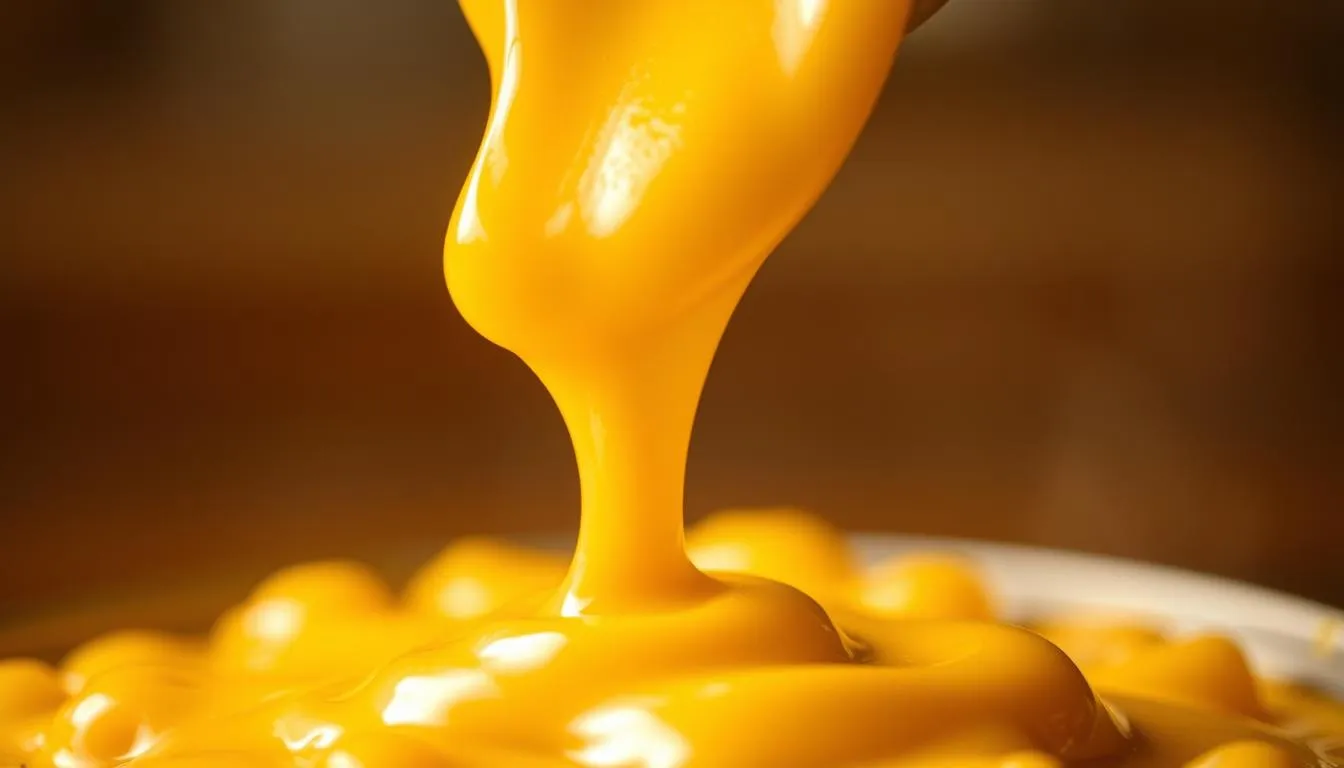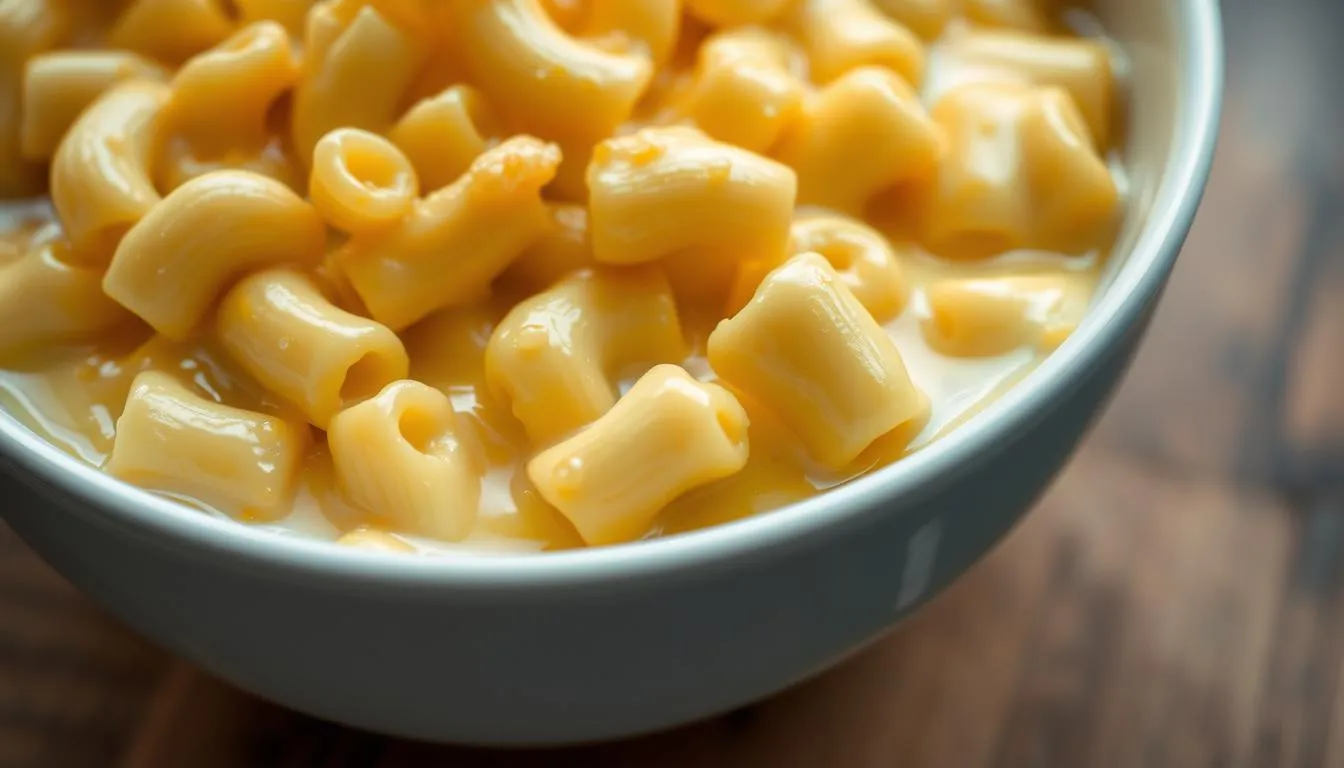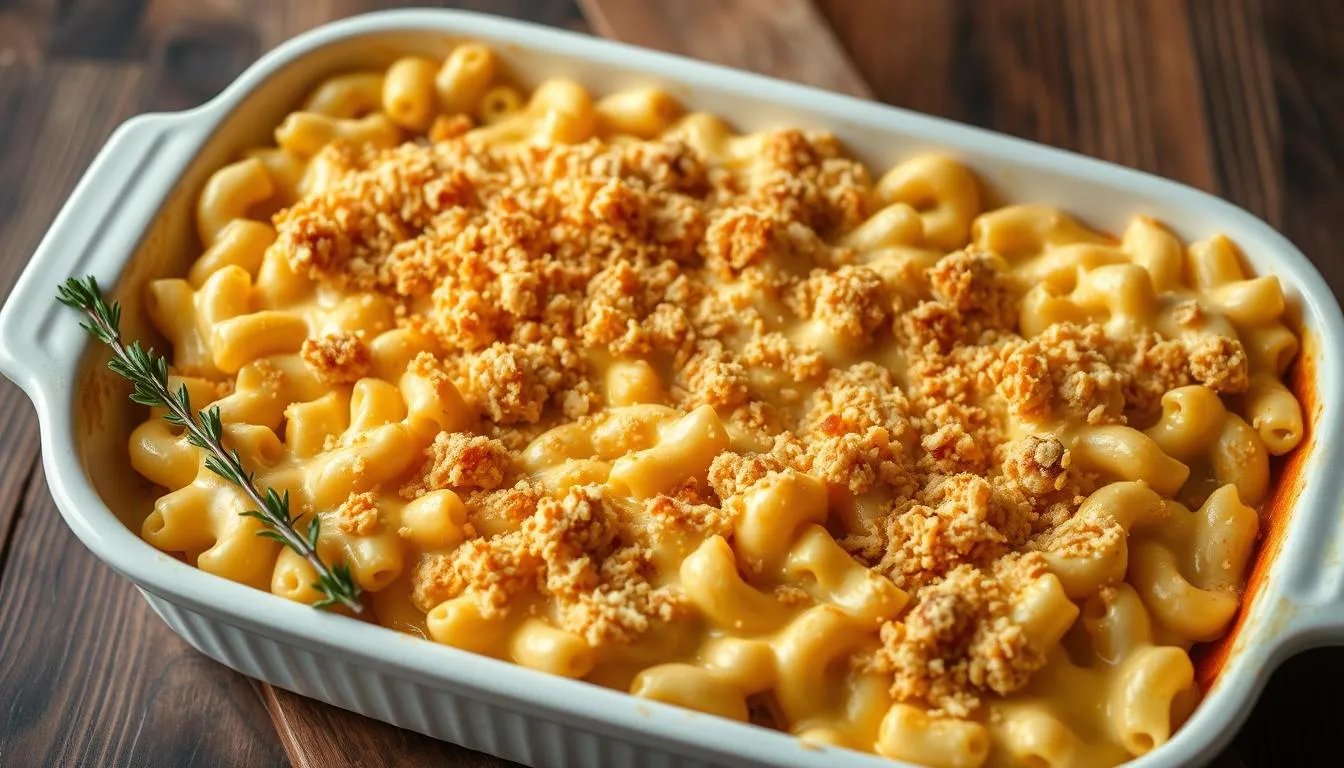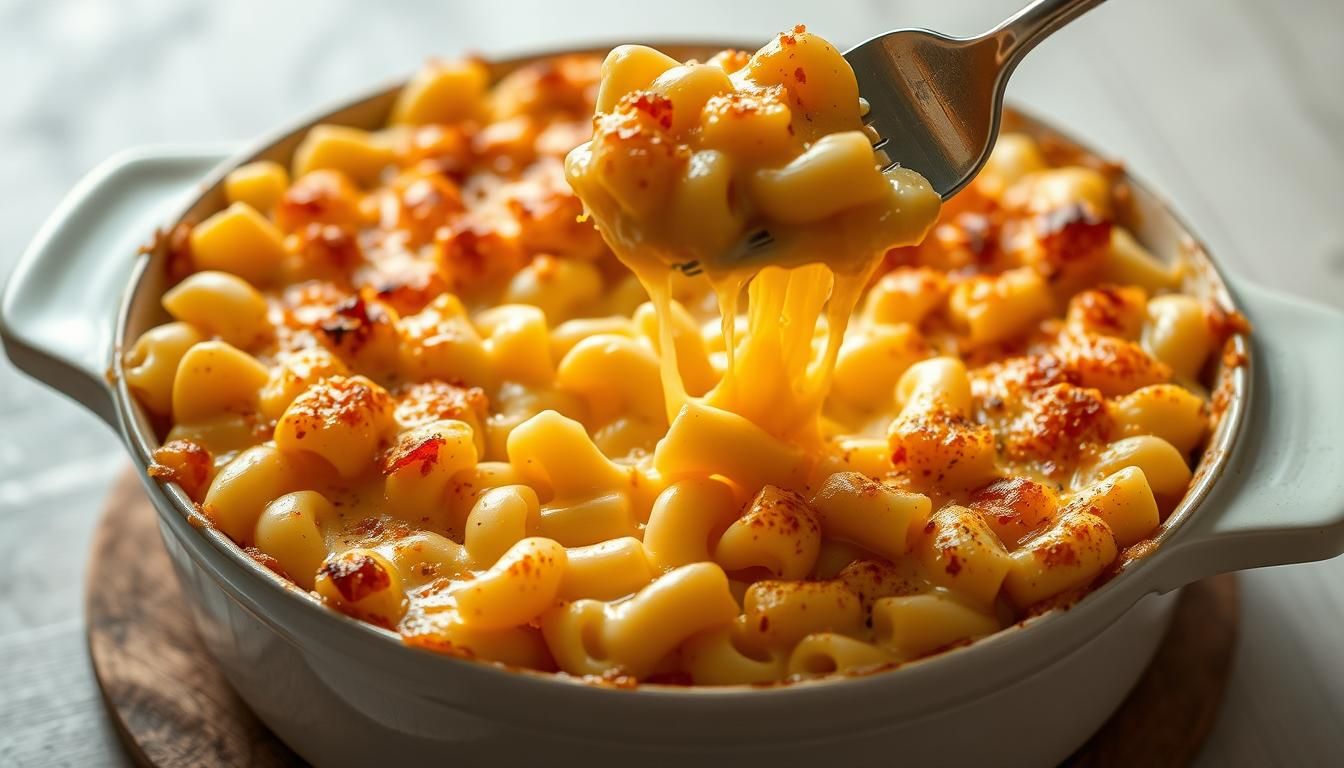There are recipes that tap into memory—warm kitchens, late-night cravings, friends gathered around a bubbling pan. This viral, comfort-forward dish did that for millions when a simple video sparked 60–90M+ views and drove fans to recreate every pull of molten goodness.
Expect rich, layered flavor: melting mozzarella, colby jack, and sharp cheddar meet a silky roux-based sauce made with evaporated milk, heavy cream, Dijon, and smoky paprika. The result is creamy, gooey, and golden on top.
Cavatappi, the corkscrew pasta, is the star for good reason. Its ridges and hollow center trap the sauce so each bite offers pockets of creamy bliss.
The method is straightforward: make a roux, whisk in the milk and cream, melt in shredded cheese, fold in pasta, then layer in a 9×13 pan, bake, and broil for a bubbly crown.
Hand-shredded cheese gives the smoothest melt and the most dramatic pulls. This recipe feels fancy but stays simple, perfect for weeknights, holidays, or potlucks.
Key Takeaways
- Viral comfort dish known for creamy layers and a golden broiled top.
- Three cheeses balance meltability, flavor, and dramatic pulls.
- Cavatappi (corkscrew) pasta traps sauce for every bite.
- Core steps: roux, milk blend, melt cheese, fold pasta, bake and broil.
- Hand-shredded cheese yields a velvety, non-grainy sauce.
- Versatile for holidays, potlucks, or easy weeknight indulgence.
Why This Viral Mac and Cheese Is Worth the Hype
Crowds fell for this recipe because it delivers every texture fans crave: spoonable sauce, gooey centers, and a crisp top.
The secret: a roux-thickened base made with evaporated milk and heavy cream keeps the sauce silky and stable. Half the shredded cheese melts into that base for a creamy body while the rest is layered through and on top for dramatic pulls.
The texture trifecta is real — a saucy interior, gooey middle layers, and a broiled, lightly crisp cheese crown. Layering prevents monotony so each scoop offers new pockets of melty goodness and crunch-to-creamy contrast.
- Balanced flavor: a touch of Dijon and smoky paprika cuts richness without stealing the show.
- Party-ready: it shines at holidays, game days, and potlucks as a side or main.
- Practical: shred ahead and follow simple, repeatable steps for reliable results.
Quick comparison
| Feature | Why it matters | Guest impact |
|---|---|---|
| Roux-thickened base | Stable, silky texture | Spoonable, velvety bites |
| Layered cheeses | Varied melt and pulls | Visual drama and rich mouthfeel |
| Broiler finish | Toasty, browned spots | Contrast of crisp and creamy |
| Simple seasoning | Keeps flavor lively | Appeals to many palates |
What You’ll Need: Equipment and Prep
Gathering the right tools makes this recipe flow from stovetop to oven without a hitch.
Essential cookware
Large pot, colander, and wide skillet: Boil pasta, drain cleanly, and build the roux and sauce in one pan for even heat.
Bakeware and graters
Use a 9×13-inch baking dish for proper depth and even browning. A rotary or box grater speeds hand-shredding and avoids anti-caking agents that hurt melt.
Small tools and prep
Accurate measuring cups and spoons, a sturdy wooden spoon or silicone spatula, and mise en place keep cooking smooth. Pre-measure flour, butter, and liquids before the roux bubbles.
| Item | Why it matters | Quick tip |
|---|---|---|
| Large pot | Roomy for even pasta cooking | Salt water generously |
| 9×13-inch dish | Depth for layering without overflow | Center rack for baking, upper for broil |
| Rotary grater | Finer, faster shredded cheese | Divide cheese: half for sauce, half for topping |
| Wooden spoon | Stirs roux and folds pasta gently | Use silicone for nonstick pans |
Pro prep: Shred ahead, measure spices, and tent with foil for make-ahead bakes to protect the top while heating through. This small setup makes the dish reliable and stress-free for any gathering or recipe test.
Key Ingredients for That Signature Cheese Sauce
The right mix of cheeses and dairy makes this sauce sing with every spoonful. Below are the building blocks that create the silky, stretchy topping and saucy interior.
Three-cheese blend
Mozzarella provides melt and dramatic pull; use hard block mozzarella, not fresh balls. Colby jack brings mellow creaminess. Sharp cheddar gives tang and backbone.
Dairy and roux base
Make a roux with equal parts butter and flour, cooked until bubbling to ensure a stable, lump-free base. Stir in one 12-oz can evaporated milk and 2 cups heavy cream for body and silkiness without eggs.
Flavor boosters
Add a touch of Dijon mustard (or mustard powder) to brighten the richness. Season with garlic powder, smoked paprika, salt, and pepper, layering some spices early in the butter and finishing the rest after the liquids are in.
Pasta pick
Use cavatappi, the corkscrew-shaped pasta, so ridges and hollows trap every bit of sauce.
Typical amounts: 1 lb mozzarella, 1 lb colby jack, 8 oz sharp cheddar; taste for salt at the end since cheese saltiness varies. For the complete method and quantities, see the full recipe.
Step-by-Step: From Roux to Golden Cheese Top
Follow a tight sequence so the sauce stays silky and the bake holds its shape.
Start smart: Cook the pasta to al dente so the pasta keeps texture after bake. Shred all cheese, mix to blend, then split into two equal bowls—half for the sauce and half for layering later.

Build the roux and enrich the sauce
Melt butter, bloom half the seasonings, then whisk in flour and cook 1–2 minutes to remove the raw taste. Slowly stream in 12 oz evaporated milk while whisking.
When the mix starts to thicken, add 2 cups heavy cream, the rest of the seasonings, and 1 tbsp dijon mustard. Stir until smooth and slightly thickened—this is your stable cheese sauce base.
Add cheese, fold pasta, and assemble
Add shredded cheese in handfuls, letting each batch melt fully before the next so the sauce stays glossy. Then fold in the drained pasta gently so each noodle is coated without breaking the spirals.
Butter a 9×13 dish. Layer half the pasta, sprinkle half the reserved shredded cheese, add the rest of the pasta, then cover with the final cheese blanket.
Bake, broil, rest
Bake at 350°F for 25–30 minutes until heated through. Finish under the broiler 1–2 minutes for those signature browned bubbles on the cheese top—watch the last minutes closely.
Let the casserole rest a few minutes before scooping so the layers set for clean servings. Tight prep—pre-measure liquids and spices—keeps the whole cooking time efficient.
Tini’s mac and cheese
Layering the pasta and sauce in two stages creates molten pockets that surprise with every bite.
The layering technique that creates pockets of gooey cheese
Split the sauced pasta into two additions: scatter half the noodles into the dish, then add a thin, even sprinkle of reserved shredded cheese in the center before adding the rest of the pasta.
Even distribution of the middle layer ensures each scoop includes saucy noodles and a molten core. Use hard block mozzarella, colby jack, and sharp cheddar for both stretch and flavor.
Hand-shredded cheese melts cleaner and avoids clumping so layers stay distinct and glossy.
Timing: bake minutes and broil minutes for the perfect crust
Bake at 350°F for 25–30 minutes until the edges bubble and the center is hot through. Taste a corner noodle to confirm full heat before you broil.
Finish under the broiler 1–3 minutes to brown the cheese top. Watch constantly—the shift from golden to too-dark can happen in under a minute.
Let the dish rest a few minutes after broiling so the interior sets and servings hold their shape. For extra pulls, add half more cheese in the middle; for a crisper crown, pile it on top.
Pro Tips for Silky, Not Gritty, Mac
Small technique changes are all it takes to keep the sauce glossy and smooth.
Shred your own cheese. Pre-shredded blends contain anti-caking agents that can make a sandy texture. Hand-shredding melts cleaner and gives predictable flavor and melt.
Choose hard block mozzarella rather than fresh balls. Fresh varieties hold water and can break the emulsion when heated.
Build the roux gently. Whisk flour and butter over medium heat so the raw taste cooks out without browning. Add warm milk slowly while whisking to form a steady base.

- Season in stages: bloom garlic and paprika early, then finish with mustard powder, salt, and pepper after liquids are in.
- Keep heat medium–low and add cheese in small handfuls so it emulsifies into the sauce.
- Use a spatula to scrape the pan while melting to prevent scorching.
- If the sauce tightens, loosen with a splash of warm dairy before folding in pasta.
- Taste before salting—cheeses vary in salt level. Finish under a gentle broil for a golden top without drying the interior.
Swaps, Variations, and Add-Ins
A few smart swaps and add-ins let you tailor the bake to pantry items or guests’ tastes.
Mustard and milk swaps: Use 1 tsp mustard powder if Dijon is not on hand — it gives similar lift. Whole milk can replace evaporated milk; the sauce may be slightly lighter, so simmer a bit longer to thicken.
Cheese alternatives: Try gruyere or fontina for a deeper, nutty melt. Extra sharp cheddar brings tang; reduce mozzarella slightly for a less stretchy, creamier top. Keep a balance: bolder cheeses often benefit from a touch more cream to keep the sauce glossy.
- Proteins and veg: crisp bacon, shredded rotisserie chicken, drained pulled pork, or tender broccoli—all pre-cooked and patted dry to avoid watering the sauce.
- Pasta swaps: elbows, shells, or rotini work well; choose shapes with ridges or hollows so the sauce clings.
- Spice tweaks: add extra smoked paprika for depth or a pinch more garlic powder for warmth and bright flavor.
Make-Ahead, Bake Later: Stress-Free Hosting
Prep ahead to enjoy the party—assemble the casserole the day before and let the oven do the rest.
Cool fully before sealing. Once layered, let the dish sit on the counter until it reaches near-room temperature. This prevents steam from pooling and soggy pasta.
Wrap tightly with plastic wrap or foil and refrigerate up to 2 days for best texture and flavor retention.

Refrigerate before baking: how to cover, chill, and bake
Before baking, let the casserole rest 30–45 minutes at room temp so it heats evenly. If baking straight from chill, plan extra minutes in the oven—cover to warm the center without burning the top.
From frozen: foil tenting and extended bake time
For frozen bakes, tent loosely with foil and add substantial extra bake time. Uncover to brown, then broil briefly to get bubbly spots.
- If the top browns too fast, re-cover loosely with foil.
- Use a thermometer: target a piping-hot center before broiling.
- Label with the date so you track fridge or freezer time during holiday prep.
Serving, Pairings, and Presentation
Serve this bake straight from the oven so every bite shows off that glossy, browned top.
Present it hot. Bring the dish to the table right after broiling for peak gooeyness and dramatic pulls. A family-style cast-iron or ceramic pan keeps heat longer and looks inviting on the table.
Offer the dish as a main with a crisp salad, or pair it as a luxe side with brisket, pulled pork, ham, or roasted chicken. For holiday spreads, add sweet potato casserole, scalloped potatoes, creamed greens, and cranberry sauce for balance and contrast.
Garnishes and finishing touches
Add color with chopped parsley or snipped chives. A light scatter brightens the top and gives a fresh note against the rich flavor.
- Present it hot from the oven for the best pulls and a creamy interior that spoons beautifully.
- Scoop in generous squares or spoon servings to showcase the layered interior and browned top.
- Provide a serving spoon and a wide spatula to help preserve layers when plating.
- Keep warm on low for buffet lines to protect the sauce from drying out.
- Set a small bowl of extra herbs or a pepper grinder nearby so guests can finish to taste.
Leftovers, Storage, and Reheating
Smart storage and gentle reheating are the secrets to keeping the sauce glossy and the pasta tender.
How to store without drying out the sauce
Cool the bake completely before sealing. Transfer cooled portions into airtight containers and refrigerate up to 3–4 days to preserve moisture and flavor.
Use a tight lid to block fridge odors and keep the sauce from skinning. If you saved a little reserved sauce or extra evaporated milk, tuck half a tablespoon into the container to help keep the interior silky.
Taste and adjust salt and pepper after reheating, since chilled dishes often mute seasoning.
Reheat strategies: oven, broil finish, or stovetop with a splash of cream
For oven reheating, cover the dish and warm gently at a moderate temperature until heated through—about the right number of minutes depends on portion size. Then uncover and broil briefly to refresh the top.
On the stovetop, reheat single servings low and slow. Stir frequently and add a splash of heavy cream or milk to loosen the cheese sauce and bring back shine. Avoid boiling to prevent the emulsion from breaking.
- Reheat only what you plan to eat; repeated cycles dry the pasta.
- If a portion feels tight, add dairy in small stages until the texture loosens.
- Portion into single-serve containers for quick lunches and even reheating.
- For more tips, see these make-ahead tips for the full recipe approach.
Conclusion
Consistency comes from small choices — warmed dairy, slow melting, and that last minute under the broiler.
Recap: a classic roux boosted with evaporated milk and heavy cream creates a stable, velvety sauce that holds up through baking. The three-cheese blend delivers stretch, body, and bright tang in each forkful.
Layering with a quick broil gives gooey pockets and a golden top. This recipe stays flexible — swap cheeses, add proteins, or change shapes to suit your pantry.
Prep ahead, chill, then bake for about 25–30 minutes, rest briefly, and garnish with herbs. Try this tini mac cheese or serve the tini mac as a proud main or side, then share your tweaks.
FAQ
What type of pasta works best for this recipe?
Cavatappi, also called corkscrew pasta, is ideal because its spirals trap sauce and melted cheese. Elbows, shells, or rotini are good substitutes if needed.
Which three cheeses create the signature sauce?
A blend of sharp cheddar, colby jack, and mozzarella (use block mozzarella, not fresh) gives a balanced melt, flavor, and stretch.
Can I use pre-shredded cheese?
It’s better to shred from blocks. Pre-shredded blends often contain anti-caking agents that can make the sauce grainy.
What dairy and thickener form the base of the sauce?
Start with a butter-and-flour roux, then whisk in evaporated milk and heavy cream for richness and smooth texture.
How do I prevent a gritty or separated sauce?
Heat gently, add cheese off the direct heat in small batches, and stir constantly. Avoid boiling after cheese is added and season gradually.
Is Dijon mustard necessary?
Dijon adds brightness and depth. If you prefer a milder note, mustard powder or a small spoon of yellow mustard can work as swaps.
What oven times give the best results?
Bake until bubbly and set, then finish under the broiler for a few minutes to brown the top. Exact minutes depend on oven and dish size—watch closely while broiling.
Can I prepare this ahead for a party?
Yes. Assemble, cover, and refrigerate before baking. For frozen storage, tent with foil and extend bake time until heated through.
How should I reheat leftovers without drying them out?
Reheat in a low oven with a splash of cream or milk to restore creaminess; finish briefly under the broiler for a fresh top if desired.
What add-ins work well with this dish?
Crisp bacon, pulled pork, shredded chicken, or roasted broccoli are popular. Stir ins before baking or layer on top for texture contrast.
Any tips for seasoning and flavor balance?
Season in stages—salt the pasta water, taste the sauce before baking, and use garlic powder and smoked paprika to boost savory notes without overpowering cheese.
Can I swap dairy for lower-fat options?
You can use whole milk instead of heavy cream and evaporated milk for some richness, but the sauce will be thinner. Adjust the roux thickness to compensate.
How much cheese should I reserve for the top?
Set aside roughly a quarter of the shredded cheese to sprinkle on top for the final bake and broil; this creates those golden, gooey pockets.
